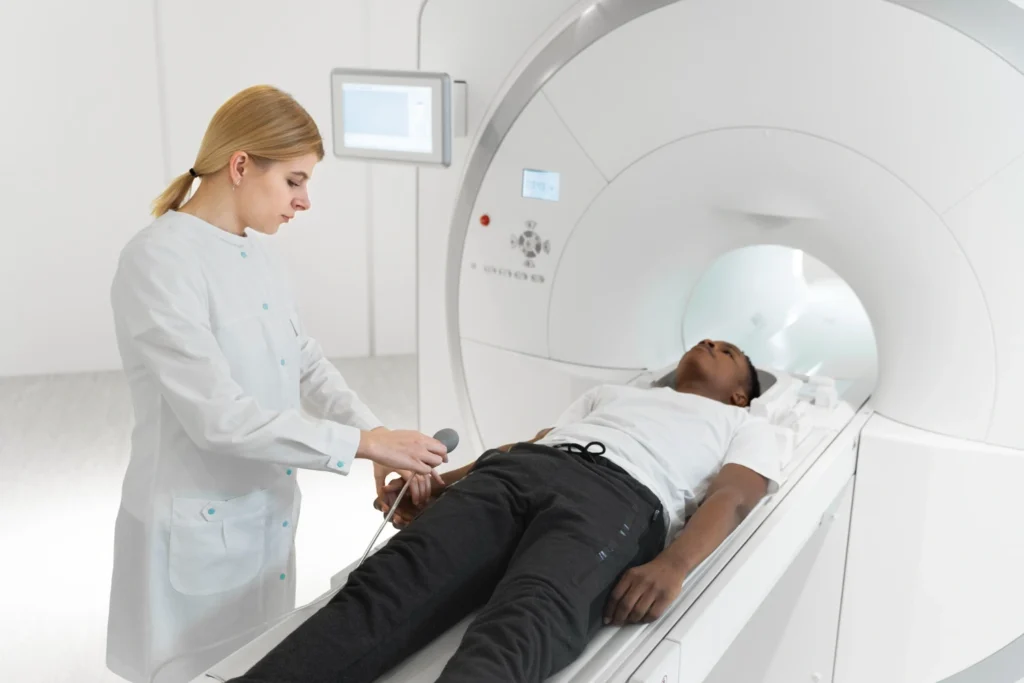Colorectal cancer remains one of the most common and preventable cancers worldwide. Early detection through routine screening plays a pivotal role in reducing mortality rates. Among the available screening methods, colonoscopy and CT colonography are two prominent options. While both procedures are effective in identifying abnormalities, they differ significantly in approach, preparation, and associated risks. Understanding colonoscopy vs. CT colonography differences is crucial for patients and healthcare providers to select the most appropriate screening method based on individual health factors, risk profiles, and personal preferences.
This article examines the advantages, disadvantages, and practical considerations of both colonoscopy and CT colonography to provide a comprehensive comparison.
In This Article
Understanding Colonoscopy
Colonoscopy is widely regarded as the gold standard for colorectal cancer screening. This procedure involves the insertion of a flexible tube equipped with a camera (colonoscope) into the rectum, allowing physicians to examine the entire colon. Beyond detection, colonoscopy also offers therapeutic capabilities, such as the removal of polyps or biopsy sampling during the procedure.

Advantages of Colonoscopy
Colonoscopy’s primary advantage is its comprehensive diagnostic and therapeutic potential. By directly visualizing the colon’s inner lining, physicians can detect small polyps, abnormal growths, and early-stage cancers with high precision. Studies show that colonoscopy has a sensitivity rate of over 95% for detecting significant colorectal lesions.
Moreover, colonoscopy enables immediate polypectomy — the removal of suspicious growths — reducing the need for additional procedures. This intervention is critical in colorectal cancer prevention, as removing precancerous polyps significantly reduces the risk of malignancy.
Colonoscopy is also recommended for individuals with a family history of colorectal cancer, inflammatory bowel disease (IBD), or genetic syndromes such as Lynch syndrome, where thorough visualization and intervention may be essential.
Disadvantages of Colonoscopy
Despite its clinical benefits, colonoscopy presents certain drawbacks. The procedure requires extensive bowel preparation, which often involves consuming strong laxatives to cleanse the colon. This preparation can be uncomfortable and may deter some individuals from undergoing screening.
Sedation is typically administered during colonoscopy, which, while minimizing discomfort, requires patients to arrange transportation and allow recovery time. Additionally, colonoscopy carries a small risk of complications, including bleeding (particularly after polyp removal) and colon perforation. While rare, these risks must be considered for patients with underlying conditions or those taking anticoagulants.
Understanding CT Colonography
CT colonography, often called virtual colonoscopy, is a less invasive imaging technique that uses low-dose computed tomography (CT) scanning to generate detailed images of the colon’s interior. This alternative is particularly appealing for individuals seeking a minimally invasive screening method.

Advantages of CT Colonography
CT colonography requires minimal patient preparation compared to traditional colonoscopy. Although bowel cleansing is still necessary, the overall experience is generally perceived as less demanding. Unlike colonoscopy, sedation is not required, enabling patients to resume normal activities immediately following the procedure.
CT colonography excels in identifying larger polyps (typically over 10mm) and other structural abnormalities. Additionally, because CT imaging captures surrounding organs and tissues, this method may detect incidental findings, such as aneurysms or kidney stones, providing further diagnostic insights.
CT colonography is particularly suitable for patients unable to tolerate sedation, those at higher risk for complications during colonoscopy, or individuals seeking a less invasive screening experience.
Disadvantages of CT Colonography
Despite its advantages, CT colonography has limitations. While highly effective at identifying larger polyps, it is less accurate at detecting smaller lesions, which may have malignant potential. If abnormalities are discovered, patients must undergo a follow-up colonoscopy for biopsy or polyp removal, adding an extra step to the screening process.
Radiation exposure is another consideration. Although modern CT scanners minimize radiation doses, cumulative exposure from repeated screenings may be a concern, particularly for younger patients or those requiring frequent imaging.
CT colonography does not allow direct tissue sampling or polyp removal, making it less efficient for patients requiring immediate intervention.
Comparing Effectiveness: Colonoscopy vs. CT Colonography
Both colonoscopy and CT colonography are effective for colorectal cancer screening, yet their diagnostic accuracy varies based on key factors.
| Aspect | Colonoscopy | CT Colonography |
|---|---|---|
| Accuracy for Large Polyps | Highly accurate (over 95% sensitivity) | Highly accurate for polyps ≥10mm |
| Accuracy for Small Polyps | Excellent detection and removal | Less accurate for polyps <6mm |
| Sedation Requirement | Yes (requires recovery time) | No (immediate return to normal activities) |
| Therapeutic Capability | Immediate polyp removal and biopsy | No — requires follow-up colonoscopy |
| Radiation Exposure | None | Low-dose radiation exposure |
| Bowel Preparation | Extensive bowel cleansing required | Less intensive than colonoscopy |
| Risk of Complications | Small risk of bleeding or perforation | Minimal risk of complications |
Choosing the Right Screening Method
Selecting between colonoscopy and CT colonography depends on several factors, including individual risk profiles, medical history, and patient preferences.
- High-Risk Patients: Individuals with a strong family history of colorectal cancer, IBD, or prior adenomas may benefit from colonoscopy due to its diagnostic precision and ability to remove polyps immediately.
- Patients Seeking a Less Invasive Option: CT colonography may be preferable for those concerned about sedation, recovery time, or complications associated with colonoscopy.
- Screening Frequency: Colonoscopy is typically recommended every 10 years for average-risk individuals, while CT colonography may require more frequent follow-ups (every 5 years).
Healthcare providers should engage patients in shared decision-making, addressing concerns about preparation, risks, and diagnostic goals.
Practical Considerations for Screening
When preparing for a colonoscopy or CT colonography, patients should follow their physician’s guidance closely. Effective bowel preparation significantly enhances the accuracy of both procedures. Patients undergoing colonoscopy should arrange for transportation due to sedation effects, while those opting for CT colonography can often resume daily activities without interruption.
For individuals delaying screening due to discomfort or logistical concerns, understanding these key differences may empower informed decision-making and encourage proactive colorectal cancer prevention.
Conclusion
Both colonoscopy and CT colonography are valuable tools in colorectal cancer screening, each offering distinct benefits and limitations. Colonoscopy remains the gold standard for comprehensive detection and immediate intervention, while CT colonography provides a minimally invasive alternative for patients seeking convenience and reduced procedural risks. Ultimately, the choice should align with individual health needs, risk factors, and comfort preferences. Consulting with healthcare providers can help ensure the most effective screening strategy for colorectal cancer prevention.
References
- Screening and Surveillance for Colorectal Cancer Expanded Version https://fascrs.org/patients/diseases-and-conditions/a-z/screening-and-surveillance-for-colorectal-cancer-e
- CT Colonography or Virtual Colonoscopy – Radiologyinfo.org https://www.radiologyinfo.org/en/info/ct_colo
- Colon cancer screening decisions: What’s the best option and when? https://www.health.harvard.edu/blog/colon-cancer-screening-decisions-whats-the-best-option-and-when-202206152762
- CT colonography: perforation rates and potential radiation risks – PMC https://pmc.ncbi.nlm.nih.gov/articles/PMC2956272/
- CT Colonography for Colorectal Cancer Screening – AAFP https://www.aafp.org/pubs/afp/issues/2021/0101/p55.html
- Preferences for CT colonography and colonoscopy as diagnostic … https://pmc.ncbi.nlm.nih.gov/articles/PMC3466595/
- Colon cancer screening: Weighing the options – Mayo Clinic https://www.mayoclinic.org/diseases-conditions/colon-cancer/in-depth/colon-cancer-screening/art-20046825










0 Comments